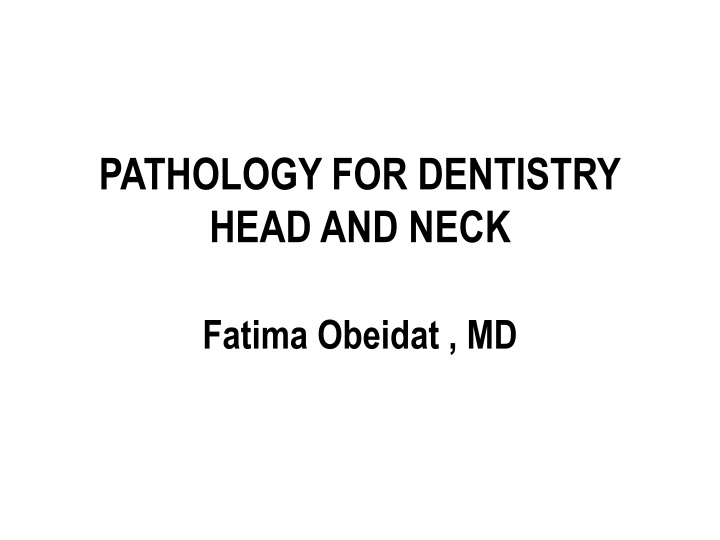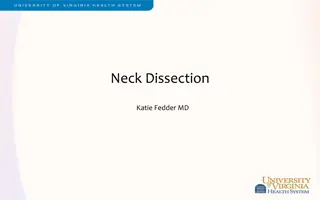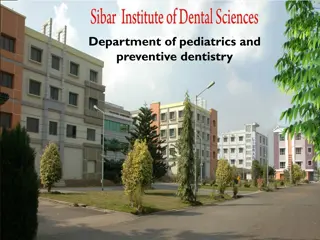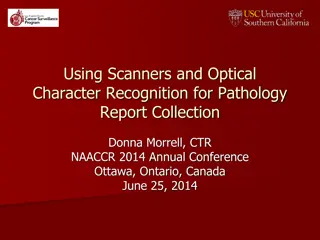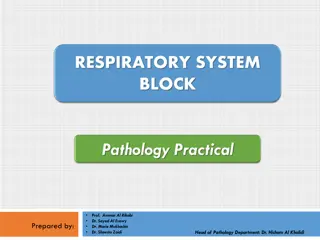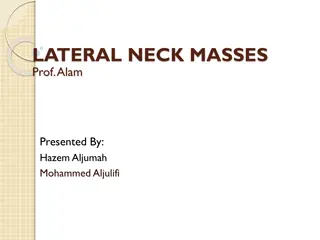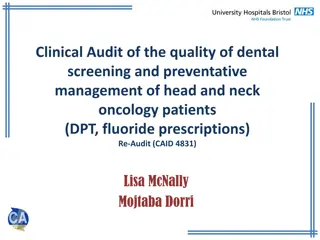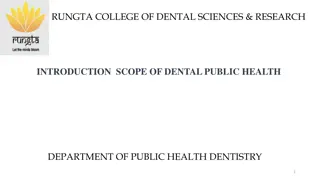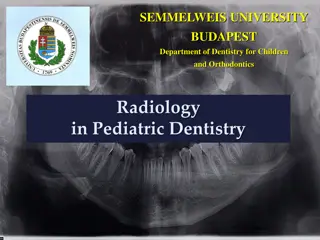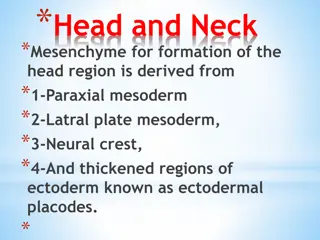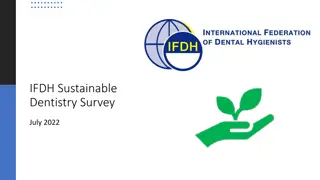PATHOLOGY FOR DENTISTRY HEAD AND NECK
In this study on oral mucosa pathology for dentistry, topics covered include inflammatory lesions like aphthous ulcers, herpes simplex, and candida, as well as proliferative and neoplastic lesions such as fibrous proliferative lesions, leukoplakia, erythroplakia, and squamous cell carcinoma. Details on the characteristics, causes, and presentations of these conditions are discussed with informative images.
Download Presentation

Please find below an Image/Link to download the presentation.
The content on the website is provided AS IS for your information and personal use only. It may not be sold, licensed, or shared on other websites without obtaining consent from the author.If you encounter any issues during the download, it is possible that the publisher has removed the file from their server.
You are allowed to download the files provided on this website for personal or commercial use, subject to the condition that they are used lawfully. All files are the property of their respective owners.
The content on the website is provided AS IS for your information and personal use only. It may not be sold, licensed, or shared on other websites without obtaining consent from the author.
E N D
Presentation Transcript
PATHOLOGY FOR DENTISTRY HEAD AND NECK Fatima Obeidat , MD
Lecture 1 Diseases of the oral mucosa
ORAL MUCOSA 1. Inflammatory Lesions: Aphthous ulcers, Herpes Simplex, candida. 2.Proliferative and neoplasticc lesions: Fibrous proliferative lesions, leukoplakia, Erythroplakia, Squamnous cell carcinoma.
A. APHTHOUS ULCERS -Are superficial mucosal ulcerations. - Affect 40% of the population. -Are more common in the first 2 decades of life - Are painful and recurrent - More prevalent within some families
- Cause is unknown. - Can be associated with a. Celiac disease , b. Inflammatory bowel diseases c. Behcet disease. - Can be solitary or multiple
- Are shallow, hyperemic ulcerations covered by a thin exudate and rimmed by a narrow zone of erythema - In most cases they resolve spontaneously in 7 to 10 days - Can recur.
B.HERPES SIMPLEX VIRAL INFECTION - Most oro-facial herpetic infections are caused by herpes simplex virus type 1 (HSV-1), with the remainder being caused by HSV-2 (genital herpes). - With changing sexual practices, oral HSV-2 is increasingly common. - Primary infections typically occur in children between 2 and 4 years of age and are often asymptomatic
- However, 10% to 20% of cases the primary infection manifests as acute herpetic gingivostomatitis, with abrupt onset of vesicles and ulcerations throughout the oral cavity. - Most adults harbor latent HSV-1, and the virus can be reactivated, resulting in a so- called cold sore or recurrent herpetic stomatitis.
Factors associated with HSV reactivation a. Trauma b. Allergies c. Exposure to ultraviolet light d. Upper respiratory tract infections, e. Pregnancy, immunosuppression, and exposure to extremes of temperature.
- The recurrent lesions, which occur at the site of primary inoculation or in adjacent mucosa innervated by the same ganglion - Typically appear as groups of small (1 to 3 mm) vesicles
CLINICAL FEATURES - Most common sites :Lips, nasal orifices , buccal mucosa , gingiva and hard palate. - Resolve within 7-10 days. - Antiviral therapy may be needed in the immunocompromised patients
HISTOPATHOLOGY -Infected cells are ballooned with large eosinophilic intranuclear inclusions
C.ORAL CANDIDIASIS (THRUSH) - Is the most common fungal infection of the oral cavity. - Candida albicans is a normal component of the oral flora and only produces disease under unusual circumstances.
- Modifying factors that cause infection by Candida Albicans nclude: a. Immunosuppression b. Only certain strains of C. Albicans cause disease c. Broad-spectrum antibiotics that alter the normal microflora.
CLINICAL FORMS A. Pseudomembranous B. Erythematous C. Hyperplastic - The Pseudomembranous form is most common and is known as thrush
PSEUDOMEMBRANOUS - Characterized by a superficial, gray to white inflammatory membrane which is composed of matted organisms surrounded by a fibrinosuppurative exudate ,which can scraped off to reveal an underlying erythematous base.
1. In mildly immunosuppressed or debilitated individuals, such as diabetics, the infection usually remains superficial, 2. In more severe immunosuppression, can spread to deep sites
a. Organ or hematopoietic stem cell transplant recipients, b. Patients with neutropenia, chemotherapy-induced immunosuppression, or AIDS.
2.PROLIFERATIVE AND NEOPLASTIC LESIONS
A.FIBROMA - Is sub-mucosal nodular fibrous tissue masses - Is formed when chronic irritation results in reactive connective tissue hyperplasia - Occurs most often on the buccal mucosa along the bite line - Treatment is complete surgical excision and removal of the source of irritation.
B. PYOGENIC GRANULOMAS - Are pedunculated masses usually found on the gingiva - Affects children, young adults, and pregnant women. - These lesions are richly vascular and typically are ulcerated, which gives them a red to purple color.
- In some cases, growth can be rapid and misdiagnosed as malignant neoplasm. - Complete surgical excision is definitive treatment
HISTOPATHOLOGY - Dense proliferation of fibroblasts and immature vessels.
C. LEUKOPLAKIA WHO DEFINITION - A white patch or plaque that cannot be scraped off and cannot be characterized clinically or pathologically as any other disease. - This clinical term is reserved for lesions that arise in the oral cavity in the absence of any known etiologic factor
NOTE: - White patches caused by lichen planus and candidiasis are NOT considered leukoplakia. - Approximately 3% of the world s population has leukoplakic lesions, - 5% to 25% of which are premalignant and may progress to squamous cell carcinoma
- Thus, all leukoplakias must be considered precancerous until proved otherwise by means of histologic evaluation. - Spectrum of histological features 1.Hyperkeratosis. 2.Dysplasia. 3.Carcinoma in situ
D.ERYTHROPLAKIA - Is a red, possibly eroded area that is flat or slightly depressed relative to the surrounding mucosa. - Is less common than leukoplakia but has a greater risk of malignant transformation( 50%)
LEUKOPLALIA AND ERYTHROPLAKIA ETIOLOGY - Multifactorial etiology - Tobacco use (cigarettes, pipes, cigars, and chewing tobacco) is the most common risk factor for leukoplakia
E.SQUAMOUS CELL CARCINOMA - It accounts for approximately 95% of cancers of the oral cavity. - This aggressive epithelial malignancy is the sixth most common neoplasm in the world - Long term survival is less than 50%. - Diagnosed at late stage.
- Multiple primary tumors may be present at initial diagnosis - Patients who survive 5 years after diagnosis of the initial tumor have up to a 35% chance of developing at least one new primary tumor within that interval. - Patients with small tumors have > 50% chance of 5 year survival but many die from second primary tumors
PATHOGENESIS TWO PATHWAYS: 1. SCC arising in oral cavity are mostly due to chronic alcohol and tobacco users - These have mutations related to carcinogens in tobacco 2. SCC arising in tonsillar crypts or bases of the tongue are related to HPV infection mainly HPV 16
- Prognosis for HPV positive tumors is better than HPV negative ones - HPV vaccine can limit the HPV associated tumors.
- The most common locations of oral cavity type are a. The ventral surface of the tongue b. Floor of the mouth c. Lower lip d. Soft palate e. Gingiva
MORPHOLOGY--Gross a. Raised firm plaques b. Irregular rough mucosal thickening c. Verrucous mucosal thickening d. As they enlarge : Form ulcerated masses with irregular borders
Histopathology - Squamous cell carcinoma develops from dysplastic precursor lesions. - Histologic patterns range from well- differentiated keratinizing neoplasms to anaplastic, sometimes sarcomatoid tumors. - Differentiation does not affect the behavior.
Histopathology of squamous cell carcinoma
Clinical Course - Oral squamous cell carcinoma infiltrates locally before it metastasizes. - The cervical lymph nodes are the most common sites of regional metastasis - Frequent sites of distant metastases include the mediastinal lymph nodes, lungs, and liver
